Exploring the Thrills of Wake Surf Hydrofoiling
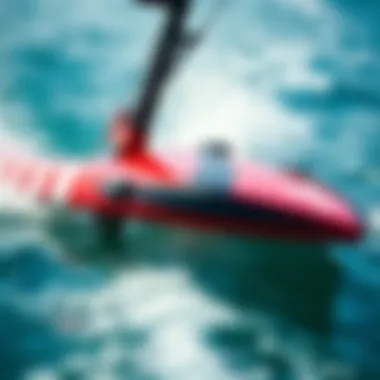
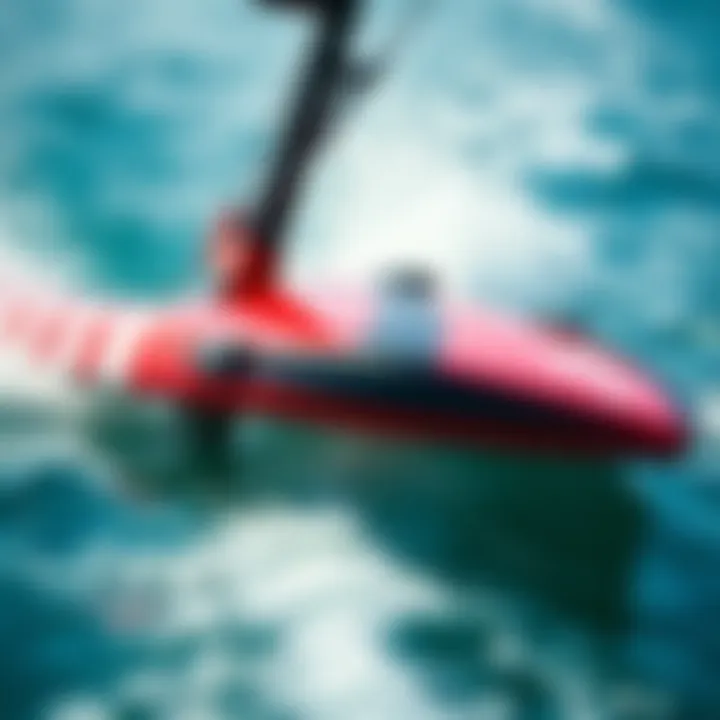
Gear and Equipment
The world of wake surf hydrofoiling is as dynamic as the waters where it thrives. Having the right gear can make all the difference between a smooth glide across the waves and a turbulent experience. Here, we'll discuss essential gear and equipment, splitting it into categories: what newcomers need to get started, and what experienced riders might want to consider.
Essential Gear for Beginners
When you’re just dipping your toes into this enthralling sport, starting with the basics ensures you not only learn effectively but also foster a safe riding environment.
- Hydrofoil Board: Choose a board that suits your height and weight. Generally, a longer board offers better stability, making it easier for beginners to find their balance. Look for models specifically designed for wake surf hydrofoiling, as they incorporate features that enhance performance.
- Hydrofoil Setup: Opt for a foil that’s user-friendly with a substantial wing area. The wings come in various sizes and shapes, affecting lift and speed. A bigger wing allows for an easier lift-off.
- Wakeboard or Wakesurf Board: Many wake surfers use a conventional wakesurf board to practice getting up and balancing before switching to a hydrofoil.
- Life Vest: Safety comes first. A properly fitting life vest with a buoyant material provides not just safety, but also comfort while riding.
- Wetsuit: Depending on the water temperature, a wetsuit can keep you warm and protected from skin irritations while you ride.
Advanced Equipment for Experienced Riders
As riders progress, they often prefer gear that allows for greater experimentation and higher performance.
- Advanced Hydrofoil Designs: For riders already accustomed to the basics, advanced foils with smaller, more responsive wings can provide thrilling speed and agility. Riders often customize their setups according to their skill level and preferred riding style.
- Carbon Fiber Boards: Lightweight and durable, carbon fiber boards boost performance by allowing quicker maneuvers in the water.
- Integrated GPS Systems: Advanced riders might find GPS devices useful for tracking their performance and honing in on precision. Many modern devices even include speed, distance, and location data.
- High-Performance Life Vests: These vests are often designed for maximum mobility and minimal drag. They might come with unique features like impact protection and additional pockets.
- Specialized Wetsuits: Thinner and more flexible, these neoprene suits offer freedom of movement and are often built for colder waters, catering to seasoned riders who thrive in diverse conditions.
Techniques and Tips
Embracing wake surf hydrofoiling is a journey in itself, entailing a balance of skill, safety, and awareness. Below are essential techniques and practices that can significantly enhance your riding experience.
Safety Practices for Hydrofoiling
The beauty of wake surf hydrofoiling can quickly turn into a nightmare if safety is overlooked. Always be mindful of your surroundings, wear appropriate gear, and follow established guidelines:
- Always Ride with a Buddy: Whether you’re on the water or prepping your gear, having a partner can increase safety and aid in learning.
- Know Your Limits: Respect your current skill level and don’t push yourself too hard too fast. Master each skill before trying something more complex.
- Consider Water Conditions: Choppy waters can throw even an expert rider off balance. Check forecasts in advance and choose calm days to practice.
Training Techniques to Improve Your Skills
Improving your wake surf hydrofoiling technique doesn’t have to be a solitary endeavor. Consider incorporating the following practices in your routine:
- Practicing Lift-Offs: Focus on your stance, lean forward slightly while keeping your knees bent. This can help your foil lift-off smoothly.
- Mind Your Weight Distribution: Experiment with shifting your weight from your front foot to your back foot. This balance will help in turning and controlling the foil more effectively.
- Video Analysis: Record your sessions to gain insights into your form and technique. Watching playback can uncover mistakes you might not notice while riding.
- Taking Lessons: Enrolling in classes can provide invaluable firsthand experience and tips from seasoned instructors, who can help you refine your skills.
- Frequent Reflection: After each ride, take a moment to reflect on what went well and what didn’t. This habit fosters continuous improvement.
"Good things come to those who learn; practice makes perfect in wake surf hydrofoiling."
With safety at the forefront and a clear understanding of equipment needs, newbies and seasoned riders alike can harness the lakes and oceans for an exhilarating experience. As this sport continues to evolve, keeping abreast of the latest gear and techniques will undoubtedly enhance your hydrofoiling journey.
Understanding Wake Surf Hydrofoiling
Wake surf hydrofoiling is carving out a niche for itself in the watersport scene, bringing together the thrill of traditional wake surfing with the unique dynamics of hydrofoils. Understanding this blend is important because it not only reveals a new realm of performance on the water but also sheds light on the evolving landscape of recreational sports.
Through diving into the nuances of wake surf hydrofoiling, one can appreciate the seamless integration of technology, technique, and the sheer enjoyment that comes with gliding above the water. For enthusiasts like kiteboarders, adventure seekers, and sports aficionados, getting a grip on these principles can greatly enhance their experience and skills.
Definition and Overview
Wake surf hydrofoiling fundamentally combines the art of wake surfing with the mechanics of a hydrofoil, a device that lifts above the water's surface. This technology allows surfers to ride on the wave generated by a boat while enjoying a sensation akin to flying just above the water, thanks to the foil lifting the board. Essentially, it’s not merely about surfing along the wave anymore but elevating the experience to glide effortlessly, minimizing resistance.
The attraction to hydrofoiling stems from its ability to create less wake and reduce drag, allowing riders to enjoy smoother rides with reduced turbulence. Riders can perform tricks and maneuvers with significantly less effort, as the hydrofoil supports their weight while they navigate the water’s surface. This method opens new doors for creativity in their surfing style and the potential for more advanced tricks.
Historical Context
While hydrofoiling might seem like a recent development in water sports, it has a history anchored in innovation and experimentation. The roots of hydrofoiling trace back to the early 20th century when engineers began exploring how lift could be generated underwater. These early inventors paved the way for the first hydrofoil boats, demonstrating the principles that would eventually make their way into wake surfing.
As wake surfing gained popularity in the late 1990s and early 2000s, particularly with the advent of inboard boats designed specifically for creating optimal wake conditions, the introduction of hydrofoils seemed like the natural next step. By the late 2010s, enthusiasts began experimenting with hydrofoils meant for wake surfing, leading to the modern iteration of wake surf hydrofoiling that is now capturing waves.
The confluence of shared knowledge among wakeboarders and surfers, combined with technological advancements, created a perfect storm that allowed this sport to flourish. The community surrounding wake surf hydrofoiling is dynamic, comprising a mixture of traditional wake enthusiasts and thrill-seekers eager to ride the next wave of innovation.
As we explore the mechanics and best practices of wake surf hydrofoiling, understanding its roots in history provides context for its development and the excitement surrounding this evolving sport.
The Mechanics of Hydrofoils
Understanding the mechanics behind hydrofoils reveals the intricate relationship between design, engineering, and performance in wake surf hydrofoiling. These surfboards employ a unique lift system that enables riders to glide above water, providing a novel riding experience that distinguishes it from traditional wake surfing. By comprehending how hydrofoils function and their various types, enthusiasts can make informed decisions about gear selections and enhance their overall riding experience.
How Hydrofoils Work
At the core of hydrofoiling is the principle of lift, which is derived from the dynamics of fluid motion. When the hydrofoil enters the water, its shape and angle allow for the creation of differing pressures above and below its wings. This pressure differential generates lift as the hydrofoil moves forward. Simply put, when a rider accelerates to a certain speed, the hydrofoil sinks just below the water's surface, allowing the board to rise up, minimizing water drag and allowing for smoother navigation across the surface.
It's essential to realize that the unique mechanics of hydrofoils also grant riders the ability to tackle rougher water conditions with increased stability. Riders can carve through waves freely, gaining confidence and a sense of control over their experience, unlike traditional surfing where maintaining balance can be more cumbersome.
Types of Hydrofoils
There’s a variety of hydrofoils available, each crafted for specific riding styles and conditions. Selecting the right foil can greatly influence the efficacy and enjoyment of the sport.
Foil Construction
The construction of the foil is crucial for both performance and durability. Most hydrofoils are made with materials such as aluminum, carbon fiber, or fiberglass. Each offers distinct advantages:
- Aluminum Foils: Often more budget-friendly, these foils are robust and can withstand rough treatment. However, their weight can be a potential downside for performance.
- Carbon Fiber Foils: In contrast, carbon fiber foils are lightweight and provide significant strength, allowing riders to reach higher speeds and maneuver with ease. Their cost often reflects their performance benefits.
- Fiberglass Foils: These provide a middle ground, offering decent performance at a more accessible price. They may not be as lightweight as carbon fiber variants, but they perform adequately for recreational riders.
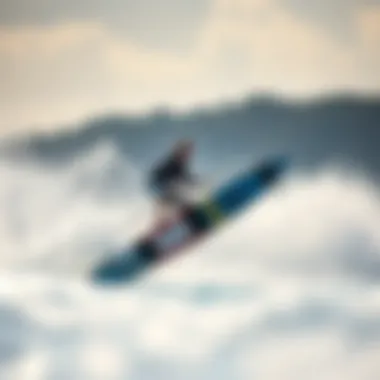
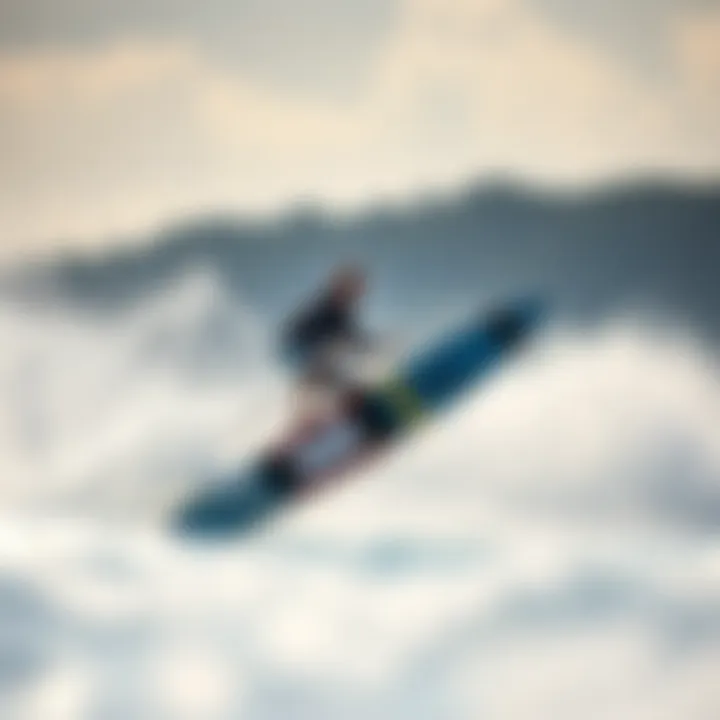
The choice of material directly affects how the foil interacts with the water. A well-constructed foil contributes to overall efficiency, enabling optimal lift and responsiveness while riding.
Shape and Design Variations
The design properties of the hydrofoil can significantly affect how it performs in the water. Hydrofoil shapes typically vary in terms of wing span and surface area, influencing lift and stability.
- Wider Wings: Generally favored for beginners, they provide ample lift and stability, essential when learning how to balance on the foil. The trade-off is that they might create more drag, slowing the rider down.
- Narrower Wings: These are tailored for experienced riders who excel at manipulating speed and require less drag. Ideal for quick maneuvers and sharp turns, they require more skill to master but reward with enhanced performance.
Moreover, the aspect ratio— the ratio of the wingspan to the wing area— plays a pivotal role in lift generation and efficiency. Higher aspect ratios produce better performance at high speeds but might sacrifice stability at lower speeds.
Choosing the right hydrofoil shape is crucial for adapting to different water conditions.
In summary, the mechanics of hydrofoils in wake surf hydrofoiling encompass a blend of design efficiency and performance strategy. By grasping how these elements work in tandem, riders can actually elevate their skills and adapt to varying conditions effectively. The right information on foil construction and shape selection will not only transform the riding experience but also deepen the understanding of this unique sport.
Wake Surfing Fundamentals
Wake surfing stands as a uniquely thrilling aspect of water sports. Combining the exhilarating elements of surfing with the innovative mechanics of hydrofoiling, it captivates enthusiasts seeking to glide over water with minimal resistance. Understanding the foundations of wake surfing is crucial, not just for beginners but for seasoned veterans looking to refine their techniques and experiences.
Basic Techniques
Mastering the basic techniques can set the stage for a vibrant wake surf hydrofoiling journey. To get started, it is key to establish balance; standing upright rather than bending too much at the knees tends to offer better stability. Start by getting comfortable on the surfboard behind a boat. Once you find your feet, focus on your weight distribution: leaning slightly back increases control over the board while ensuring you ride the boat’s wake seamlessly.
Another fundamental technique is carving. This involves shifting your weight to one side, allowing your board to cut through the wake smoothly. Carving helps in generating speed and allows for more advanced maneuvers later on. Remember, the goal is not just to remain afloat but to really harness the power of the wake to propel yourself.
Emphasis on body positioning is also vital. Keeping your body loose helps absorb any bumps caused by the wake and allows for workarounds if you’re thrown off balance. Also, practice makes perfect; hitting the water multiple times will teach you how to ride with finesse, even if it feels more like a dance with the waves than a traditional sport.
The Role of the Boat
The boat is not merely a vessel; it plays an instrumental role in the wake surf experience, providing consistency and shape to the wake that riders depend on. The wake generated is largely influenced by the boat’s weight distribution and speed, making it imperative for riders to have a good understanding of this aspect.
Wake Size and Shape
When considering the wake size and shape, various factors like boat design and weight distribution come into play. A larger wake is often beneficial as it gives surfers more options for tricks and stunts. Larger wake also provides a smoother ride, running the fine line between enjoyment and safety.
The key characteristic of appropriate wake size is the quality of the waves it creates. Riders typically look for a clean, defined peak that allows them to secure stability and perform tricks. The distinct feature of a well-shaped wake is that it fosters momentum, enabling riders to maintain speed without unnecessary effort, aiding in their progression.
However, there's a balance to maintain. A massive wake might intimidate beginners or make it tough to control speed and direction, particularly for those just getting their feet wet. Hence, understanding that a good wake is one that matches the rider’s skill level is crucial.
Boat Speed Adjustments
Speed adjustments are a significant element when it comes to wake surfing and hydrofoiling. The boat's speed affects the quality of the wake; thus, it is important not only to know how fast to go but how slight changes in speed can dramatically alter the riding experience.
The key characteristic of speed adjustments lies in finding the sweet spot. This speed allows the wake to peak at an optimal height, reducing the chance of wipeouts while still presenting plenty of challenges for the rider. The unique aspect of fine-tuning speed revolves around rider comfort zones. Slower speeds provide an easier environment for beginners, while more experienced surfers might thrive on faster speeds that enhance performance.
Nonetheless, finding this balance isn't without its challenges. Too fast, and the wake becomes choppy, leading to difficulty in maneuverability. Too slow, and the ride loses its excitement. It’s all about testing the waters—to truly excel, one must understand the dynamics of speed in relation to their unique riding style.
Understanding the fundamentals of wake surfing is key to progression and safety in this exhilarating sport.
In summary, honing basic techniques, optimizing the role of the boat, and mastering both wake size and speed adjustments significantly enhances the wake surf hydrofoiling experience. Whether you're just getting started or aiming to perfect your tricks, a solid grasp of these fundamentals lays a strong foundation for countless adventures on the water.
Combining Wake Surfing and Hydrofoiling
In the realm of watersports, the confluence of wake surfing and hydrofoiling has created an invigorating wave of excitement and innovation. This unique combination marries the thrill of riding on the water's surface with the buoyancy and awe-inspiring sensation of gliding above it. Understanding the synergy between these two activities is crucial as it not only broadens the horizons for enthusiasts but also enhances the overall experience on the water.
Why Combine These Sports?
The integration of wake surfing and hydrofoiling offers numerous advantages that significantly elevate the experience of both activities. Here are some key reasons for considering this combination:
- Enhanced Maneuverability: Hydrofoiling lends a level of agility that allows riders to navigate waves and turns with finesse. This can lead to a thrilling experience, as riders can make tighter turns and smoother transitions compared to traditional wake surfing.
- Reduced Water Resistance: One of the standout features of hydrofoiling is its ability to lift the rider above the water surface, drastically reducing drag. This results in more efficient movement and allows for high-speed maneuvers with less effort. Many find this exhilarating, as it opens the door to deeper exploration of techniques and tricks.
- Less Wind Resistance: Particularly in challenging weather conditions, hydrofoiling can provide a more stable experience. Riders often find that they’re less affected by wind when elevated above the water, allowing for longer sessions and more enjoyment.
- Expanding the Skill Set: By combining wake surfing with hydrofoiling, riders develop a more versatile set of skills. This can lead to improved confidence and capability in various water conditions, making participants more adept overall.
- Increased Access to Diverse Locations: Hydrofoils make it possible to ride in shallower waters where traditional wake surfing may be impractical. Riders can explore new spots that offer different wave dynamics and experiences without being restricted by conventional limitations.
"By learning to hydrofoil, you don’t just ride the waves—you become part of the water."
As the two sports converge, it’s evident that the benefits extend beyond just physical prowess; they also foster a sense of community among riders who are eager to share knowledge and experiences.
Hydrofoiling Techniques for Wake Surfing
Mastering the blend of hydrofoiling and wake surfing necessitates a solid grasp of specific techniques that enhance performance and safety. Here are some essential techniques that can help riders become adept in this hybrid watersport:
- Getting Up on the Foil: This initial step can be daunting for many. It involves maintaining the right posture to balance the foil's lift. Riders should focus on keeping their weight centered and using smooth movements to prevent harsh jolts that could cause them to fall.
- Maintaining Balance: Once on the foil, a rider must become attuned to subtle shifts in their weight. This requires continuous adjustments to maintain the desired elevation over the water—too far back might lead to nose diving, while too far forward can result in the rear slipping out.
- Turning Techniques: Learning to control turns while on the foil can take practice. Riders should experiment with body positioning, leaning into turns, and maintaining speed to ensure fluidity and avoid sharp cuts that disrupt balance.
- Tricks and Jumps: As riders become comfortable, they can start adding tricks. Small jumps and spins can be incorporated, but this requires a solid grasp of balance and control. Start small and build up to more complex maneuvers.
- Safety Reminders: Above all, safety measures cannot be overlooked. Always wear appropriate gear and be cautious in unfamiliar waters.
By focusing on these techniques, riders can thrive in this brilliant merging of sports, ultimately elevating their skills while having the time of their lives. As wake surf hydrofoiling continues to grow, those who participate will find not just a sport but an entire lifestyle rooted in adventure and camaraderie.
Essential Gear for Wake Surf Hydrofoiling
Gear is the unsung hero of any water sport, particularly when it comes to wake surf hydrofoiling. Having the right equipment can make or break your experience on the water. This section highlights the importance of selecting quality gear while ensuring safety, comfort, and performance in this thrilling combination of wake surfing and hydrofoiling.
Selecting the Right Foil
Choosing the right hydrofoil is a critical step for anyone looking to blend wake surfing with hydrofoiling. Foils come in various shapes, sizes, and materials, affecting how they perform on the water.
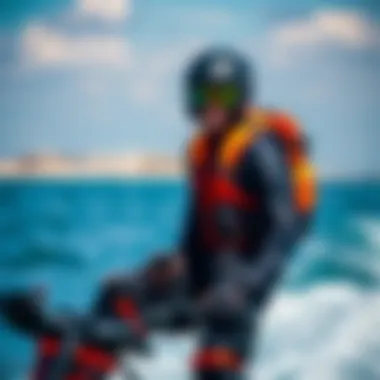
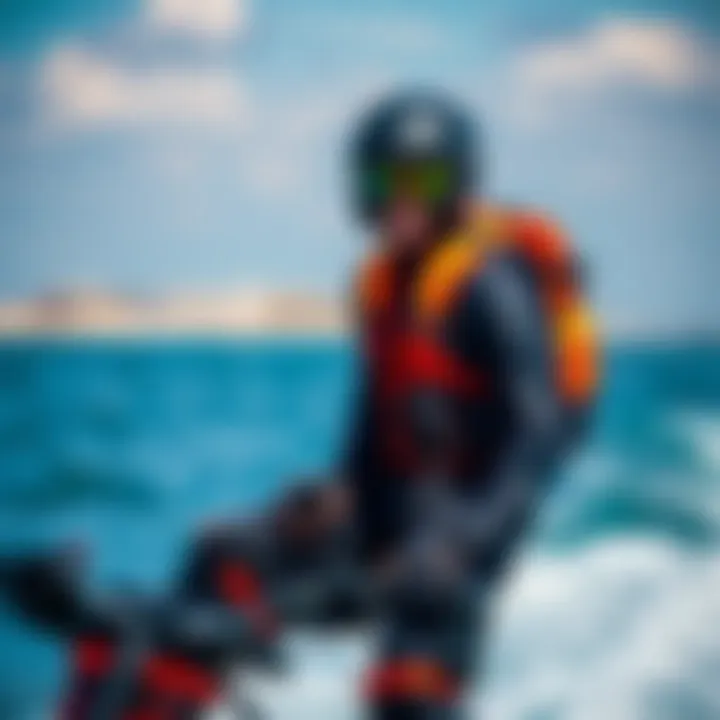
- Size Matters: Larger foils typically offer more lift, making them easier to ride for beginners. Smaller foils might be better for advanced riders, providing quicker turns and a potentially more exciting ride.
- Material Composition: Carbon fiber foils tend to be lighter, offering better performance and durability in various water conditions. On the flip side, aluminum foils are generally more affordable but may not provide the same level of responsiveness.
- Purpose: Consider what style you intend to ride. Some foils excel in flat water, while others perform better in choppy conditions. Tailoring your selection based on your riding style ensures a more enjoyable time on the water.
In summary, the foil serves as the bridge between you and the water. Opting for the right one can enhance your skills and provide a smoother experience as you navigate the transitions from wave to air.
Necessary Safety Gear
Impact Vests
Impact vests play a significant role in the overall safety of wake surf hydrofoiling. Unlike standard life jackets, impact vests are designed to offer buoyancy while allowing mobility for active maneuvers. One of the key aspects of impact vests is their lightweight construction, which doesn’t weigh you down, unlike bulkier options.
- Key Characteristic: These vests often feature foam padding that helps absorb shock during potential falls, giving you peace of mind while you’re out on the water.
- Benefits: Many riders rave about their fitting snugly without being too restrictive, allowing freedom of movement while providing crucial impact protection. They often come with a snug fit that helps in both comfort and safety.
- Drawbacks: However, impact vests may not provide sufficient buoyancy in severe situations. It’s crucial to understand your limits and accompany them with more floatation gear if necessary.
Helmet Recommendations
When you’re flying over water on a hydrofoil, protecting the noggin is imperative. Helmets designed for water sports can make a world of difference. The right helmet is not just a fashion statement; it’s a fundamental safety component that can keep you safe during unexpected falls.
- Key Characteristic: A good helmet often includes a cushioned interior and adjustable straps for a secure fit, reducing the likeliness of shifting during sudden movements. The ventilation holes are a critical feature, allowing airflow to minimize overheating.
- Benefits: Investing in a helmet ensures you’re covered against potential falls or collisions, providing peace of mind that lets you focus on enjoying the experience. Plus, a snug helmet can help you maintain better control and awareness.
- Drawbacks: On the downside, if not well-fitted, helmets can become a nuisance, leading to discomfort or distraction rather than safety. The right fit is essential, so always try before you buy.
Remember: Taking safety gear seriously isn’t just about protecting yourself; it’s about fostering a responsible water sport culture. Investing in reliable equipment helps you focus on the thrill, not the spills.
In summary, gear selection—both foils and safety equipment—is a vital component of wake surf hydrofoiling. It can elevate your riding experience while minimizing risks. So before you hit the water, make sure you’re equipped with the essentials!
Safety Considerations
Safety in wake surf hydrofoiling cannot be emphasized enough. The exhilaration of gliding across the water on a hydrofoil may make it seem like a breeze, but it comes with its own set of challenges and risks. Understanding these aspects is critical for ensuring a safe experience on the water.
Understanding Risks
When engaging in wake surf hydrofoiling, various risks come into play. Injury is one of the main concerns. Hydrofoils can reach high speeds, and without proper techniques, falls can lead to accidents. Whether it’s a hard hit with the board or being thrown off course into the water, the consequences can range from mild bruises to more severe injuries like concussions or fractures.
Environmental factors also present potential hazards. For instance, debris in the water, changing weather conditions, or even encountering unforeseen currents can affect the safety of the sport. Additionally, there’s a risk of colliding with other watercraft or hidden obstacles beneath the surface, which is something every participant should be wary of.
"Adventure without safety is merely recklessness."
Before hitting the water, it’s critical to assess the environment and ensure it is conducive to hydrofoiling. Knowledge of local regulations and understanding the behavior of other water users are also essential parts of mitigating risks.
Best Safety Practices
Engaging in wake surf hydrofoiling can be a thrilling experience when appropriate safety measures are taken. Here are some best practices that both beginners and seasoned riders should adopt:
- Wear the Right Gear: Always wear a well-fitted life jacket. An impact vest can also offer added protection when you're out on the water.
- Have a Spotter: Ensure someone is in the boat keeping an eye on the rider. Having a spotter helps in quickly identifying potential dangers and coordinating safe maneuvers.
- Know Your Limits: It’s easy to get carried away with the excitement of riding. Understanding your physical limits and practicing within them can drastically reduce the chance of accidents. Push yourself, but do so at a safe pace.
- Check Equipment: Regularly inspect your hydrofoil setup. The last thing you want is to have a malfunction while out on the water.
- Stay Aware of Surroundings: Be conscious of other watercraft and natural obstacles. Never assume that others see you or will give way.
By adhering to these practices, participants can significantly reduce the risks involved in wake surf hydrofoiling. Safety should always be a priority, allowing for a more enjoyable and fulfilling experience on the water.
A solid understanding of these safety considerations forms the bedrock of engaging in wake surf hydrofoiling. Each ride is an opportunity not only to enjoy the thrills of the sport but also to practice responsibility, paving the way for a sustainable and safe community of water sports enthusiasts.
Popular Locations for Wake Surf Hydrofoil
When delving into the world of wake surf hydrofoiling, the setting cannot be underplayed. The environment where enthusiasts engage in this sport shapes not just the experience but the quality of the ride and the safety measures required. Choosing the right location is critical for both beginners and seasoned riders. It determines the kind of waves you’ll ride, the accessibility of the area, and even the company you keep on the water. With the increasing popularity of this sport, certain destinations have emerged as favorites. Understanding these locations enhances your hydrofoiling journey.
Top Destinations
There are a few spots worldwide known for being excellent for wake surf hydrofoiling:
- Lake Tahoe, California/Nevada: This colossal lake boasts crystal clear waters and stunning mountain backgrounds. The glassy conditions here create the perfect atmosphere for foiling while taking in breathtaking scenery.
- Havasu Lake, Arizona: A popular destination for many water sports, Havasu Lake features expansive waters that provide ample space for wake forming. The mild weather throughout the year means riders can often enjoy the lake without harsh conditions.
- Canyon Lake, Texas: This man-made reservoir is well-equipped for watersports enthusiasts with its winding waterways. Canyon Lake provides calm, consistent waters which are perfect for long, uninterrupted foiling sessions.
- The Great Lakes, USA: While a bit more unpredictable, the Great Lakes can surprise even veteran riders with conditions ranging from gentle to wild rides. Popular spots like Lake Michigan can be ideal, depending on the wind patterns.
- Whitsunday Islands, Australia: Known for its warm climate and stunning surroundings, the Whitsundays offer an exotic foil experience. Riders can enjoy explorative sessions in the clear blue waters and secluded locations.
In all these locations, the natural beauty blends with the thrill of hydrofoiling, contributing to a rich overall experience that captures the essence of the sport.
Evaluation Criteria for Locations
Not all places are created equal when it comes to choosing a hydrofoiling location. Here are several key factors to consider:
- Water Conditions: Prioritize areas with consistent and manageable conditions. Calm waters without large waves or heavy currents are crucial for safe foiling.
- Accessibility: Look for locations that allow easy entry and exit for your boat. Launching ramps or beaches that provide access without excessive travel time can enhance the overall experience.
- Local Community: Engaging with seasoned riders who know the area can help you learn faster and discover hidden gems. A supportive community can make for a safer and more enjoyable experience.
- Weather Patterns: Think about the climate conditions that could affect the ride. A location with reliable weather can lead to less frustration on your adventures.
- Biodiversity and Conservation: Respecting the local ecosystem is vital. Locations that promote sustainability and have initiatives in place to protect local wildlife are favorable.
"Finding the right spot isn’t just about where the waves are; it’s about where you can enjoy a blend of beauty, challenge, and community."
Advanced Techniques and Tricks
In the realm of wake surf hydrofoiling, mastering advanced techniques can separate the seasoned riders from the greenhorns. These skills not only enhance performance but also make surfing on a hydrofoil more enjoyable. Riders who push their limits and dare to experiment with new tricks can enjoy a more thrilling ride. Understanding the nuances of these techniques becomes vital for anyone looking to elevate their experience.
Progressing Your Skills
To really get to the next level in wake surf hydrofoiling, continual skill progression is essential. This takes time and practice. Start with the basics, but don't linger there too long. The beauty of hydrofoiling lies in its ability to innovate; thus, learning tricks like the 180 or 360 can change how one interacts with the water.
Here are some techniques to consider as you progress:
- Carving Turns: Carving isn’t just about speed; it’s about control and utilizing the foil’s lift to its fullest. Lean into your turns; use your body weight to grip the board more effectively.
- Small Jumps: Once comfort is found in turns, try small uplifts. Just a few inches can create a whole new level of excitement.
- Switch Riding: Being able to ride both regular and switch can dramatically improve your skills. It adds versatility and balance to your hydrofoiling game.


Practicing these techniques not only boosts confidence but helps refine control. Remember, even small incremental changes can lead to significant improvements over time.
Learning from Experts
Nothing beats firsthand knowledge gained from those who have walked the walk. It’s wise to seek out the pros or attend workshops dedicated to hydrofoiling. Being near experienced riders allows newcomers to absorb techniques that textbooks can’t teach.
Things to consider when learning from experts include:
- One-on-One Lessons: Personalized instruction might tackle specific weaknesses and bolster strengths. Aim for tailored lessons focusing on areas you wish to perfect.
- Video Analysis: Many experienced rideers utilize slow-motion videos to dissect performances. This visual feedback helps highlight areas for improvement that may go unnoticed in real-time.
- Joining Local Meet-Ups: Finding a community interested in similar activities can provide ongoing support and motivation. Additionally, it encourages the sharing of tips and tricks that make learning enjoyable.
Ultimately, learning from seasoned pros can fast-track your skills, transforming cumbersome maneuvers into fluid actions.
"Improvement is not about sudden jumps; rather, it’s the accumulation of small victories that ultimately count."
There are many resources for riders, including forums on Reddit or instructional content on platforms like YouTube. Utilize these to connect with the broader community and gather insights from different perspectives. Participate in discussions on sites such as www.reddit.com/r/wakesurfing or check expert articles on www.britannica.com. The wealth of information available is vast and can be the key to unlocking your full potential in wake surf hydrofoiling.
Community and Connections
In the realm of wake surf hydrofoiling, the sense of community plays a pivotal role in the growth and popularity of the sport. For enthusiasts and newcomers alike, connecting with like-minded individuals fosters a supportive environment where knowledge, experiences, and skills are shared. The value of community extends beyond mere camaraderie; it creates networks of resources, encouragement, and innovation that can significantly enhance one’s journey in wake surf hydrofoiling.
Connecting with Enthusiasts
Connecting with fellow wake surf hydrofoiling enthusiasts allows individuals to dive deeper into the nuances of the sport. These interactions often take many forms – from local meet-ups and riding sessions to broader events like competitions and exhibitions. When surfers share rides together, they don't just exchange tricks; they tap into a wealth of insights regarding optimal techniques and gear. Networking in this way also provides a sense of belonging.
Here are a few ways to connect with fellow enthusiasts:
- Local Clubs: Joining a wake surf hydrofoil club can provide invaluable insights and regular meet-ups. Clubs often have seasoned veterans who can mentor newcomers.
- Workshops and Clinics: Engaging in guided sessions, usually organized by local shops or experienced riders, offers hands-on experience and knowledge sharing.
- Group Rides: Often, enthusiasts organize informal group rides through social media. Participating in these gatherings provides immediate feedback and can boost confidence.
By engaging in these activities, riders not only improve their skills but also establish lasting friendships which can lead to a more fulfilling surfing experience.
Online Resources and Forums
In today’s digital age, leveraging online resources is essential for any aspiring wake surf hydrofoiler. Various forums and social media platforms serve as hubs for both information exchange and community bonding. With so many online platforms available, one can easily find tailormade discussions that suit their specific interests or concerns.
Some recommended online spaces to explore include:
- Reddit: Subreddits like r/wakesurf provide a platform for users to share tips, techniques, and advice. Here, discussions can vary from beginner tips to advanced tricks, making it a goldmine for information.
- Facebook Groups: Groups centered around wake surf hydrofoiling allow members to post questions, share experiences, and organize local meet-ups. Some actively facilitate events, showcasing opportunities for all levels.
- YouTube Channels: Many seasoned riders share their experiences and tutorials on platforms like YouTube. Engaging with these videos can offer visual demonstrations of techniques that are much easier to comprehend than textual descriptions.
"Community is not just about sharing a passion; it's about lifting each other up in pursuit of greatness."
Environmental Impact and Conservation
Understanding the environmental implications of wake surf hydrofoiling is no small feat. As this watersport rides a wave of popularity, it becomes crucial to recognize the balance between enjoyment and ecological responsibility. The waters we play in are precious ecosystems, often home to delicate flora and fauna. Consequently, as thrill-seekers, it’s imperative to engage in practices that help protect these environments rather than degrade them.
Understanding Environmental Concerns
Engagement in wake surf hydrofoiling, like any other water sport, can introduce several environmental concerns. One of the foremost issues is the potential for pollution. Fuel emissions from motorboats can have detrimental effects on water quality. Moreover, the wake generated by boats might lead to erosion of shorelines. This can disrupt habitats that various species rely on for survival. Other negative aspects include disruption to wildlife, particularly during breeding seasons.
Protecting Marine Life: Certain aquatic habitats are vulnerable to disturbances. For example, nesting birds often frequent coastal areas. These birds can easily be startled by loud craft noises or abrupt movements on the water. Keeping this in mind, it's crucial for enthusiasts to respect these habitats. Here are a few points to ponder:
- Reduce your speed in sensitive areas.
- Avoid driving too close to shorelines.
- Watch for wildlife signs.
By recognizing these concerns, participants can foster respect for the environment, ensuring they don’t indulge at nature's expense.
Promoting Sustainability in the Sport
As wake surf hydrofoiling continues to grow, promoting sustainable practices becomes vital for its future. Many manufacturers are already exploring eco-friendly materials and practices. Riders can make conscious choices to play their part in safeguarding our natural resources.
Several initiatives can aid in mitigating the negative impact of wake surf hydrofoiling:
- Eco-Friendly Equipment: Seek out boards and foils made from sustainable materials, such as recycled plastics or natural fibers. This helps reduce the overall carbon footprint.
- Fuel Alternatives: When selecting a boat, consider models that utilize renewable energies or more efficient fuel systems. Electric wake surf boats are growing in popularity, reducing harmful discharge into waterways.
- Education & Awareness: Join local conservation groups. Engaging in community efforts raises awareness about the importance of preserving aquatic environments. This might involve cleanup activities or awareness campaigns that educate others about the local ecosystems affected by these sports.
Remember, a clean environment today allows for countless waves of enjoyment tomorrow.
Participating in sustainable practies ensures that wake surf hydrofoiling is not merely a transient trend but a sport that can thrive harmoniously with the natural world, allowing future generations to experience the thrill and beauty of wake surf hydrofoiling.
The Future of Wake Surf Hydrofoiling
As we look towards the horizon of wake surf hydrofoiling, it’s clear that this activity is not just a passing trend but a sport with promising potential for growth and innovation. The marriage of wake surfing and hydrofoiling brings a fusion of excitement that attracts both seasoned riders and novices alike. Key aspects that will contribute to shaping the future of this sport are emerging trends, technological advancements, and ongoing commitment to safety and environmental considerations.
Emerging Trends
In recent years, several trends have started to surface that will likely shape the wake surf hydrofoiling landscape:
- Increased Popularity: More individuals are becoming aware of the exhilarating experience hydrofoiling offers. As more people take to the water with this gear, we can expect a natural increase in the community surrounding this sport.
- Diversity in Equipment: We’ve seen manufacturers expand their offerings. From lighter materials to more robust construction, the evolution of foil designs is paving the way for personalized riding experiences. Different styles are emerging tailored to varying skill levels – something every rider should take into account before hitting the waves.
- Emergence of Youth Programs: New initiatives aimed at teaching younger generations the basics of hydrofoiling are popping up. This opens pathways to maintain a thriving community, ensuring that the sport’s vitality is not lost as older generations transition out.
- Online Learning Platforms: As the world becomes more digitally connected, many are turning to video tutorials and virtual coaching. Online gatherings and forums serve as hubs for sharing tips and experiences, breaking geographical barriers that often hinder traditional learning methods.
Potential Innovations
Anticipating the future of wake surf hydrofoiling isn’t merely speculation; it’s grounded in observable developments within the sport and relevant technology:
- Advanced Materials: Hydrodynamic designs combined with lighter, yet durable materials may redefine the performance of hydrofoils. Imagine a foil that not only cuts through water with surgical precision but also enhances efficiency, reducing fatigue during longer sessions.
- Smart Technology Integration: Wearable devices and smart foils could soon provide feedback on a rider's performance. Such innovations could offer real-time data about speed, balance, and wave conditions, creating an even more tailored experience.
- Eco-Friendly Approaches: As awareness grows about environmental sustainability, manufacturers may increasingly focus on creating gear that minimizes ecological impact. Biodegradable materials and sustainable production practices could lead the way, making wake surf hydrofoiling a more environmentally conscious choice.
- Augmented Reality (AR): AR could revolutionize skills training by providing visual cues directly in the user’s field of vision. Knowing your stance or angle as you ride could make learning these vital skills easier, helping beginners progress faster.
The road ahead for wake surf hydrofoiling is paved with opportunities for innovation and connection, offering a thrilling experience that continues to resonate with a wider audience.
The future of wake surf hydrofoiling hinges on collective passion, technological advancement, and an ongoing commitment to enjoying the sport responsibly. As it evolves, participants in this exhilarating sport will drive its direction, ensuring it remains dynamic and engaging for years to come.



